35+ Colorful Tetra Species for Nano Aquariums and Beyond (5-55 Gallons)
Tetras are among the most beloved freshwater fish—small, peaceful, and bursting with color. From the glowing blue of neon tetras to the fiery red of serpaes, these fish offer endless variety for hobbyists of all levels. While they’re generally hardy and beginner-friendly, tetras thrive best in groups and slightly acidic water. A 20-gallon tank is a good starting point, especially if you’re planning to keep a vibrant school.
In this guide, we’ll introduce you to over 35 stunning tetra species—from nano tank favorites to showstoppers for larger aquariums—along with care tips to help you choose the perfect additions to your underwater world.
- Tetras for Nano Aquariums (5–15 Gallons)
- Tetras for Mid-Sized Aquariums (20–25 Gallons)
- Tetras for Large Aquariums (29+ Gallons)
- General Tips for Tetra Tanks
- Final Thoughts
Tetras for Nano Aquariums (5–15 Gallons)
Nano aquariums are perfect for hobbyists with limited space or those seeking a compact, visually appealing display. While larger tanks offer more flexibility, these small tetras thrive in setups as small as 5–15 gallons when their specific needs are met.
Ember Tetra
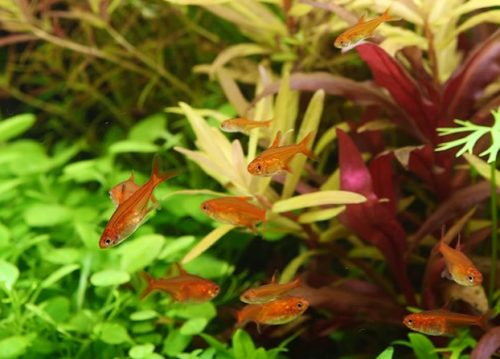
- Scientific name: Hyphessobrycon amandae
- Size: Up to 0.8 inches
- Tank size: Minimum 5 gallons
- Care level: Easy
- Temperament: Peaceful
- Water parameters: 68–82°F, pH 5.0–7.0, soft to moderately hard water (4–8 dGH)
- Diet: Omnivore (flake foods, micro-pellets, frozen or live brine shrimp, daphnia)
- Lifespan: 2–4 years
Ember tetras are among the smallest tetras, ideal for nano aquariums as small as 5 gallons. Their vibrant orange-red coloration and lively personalities add a striking visual to small setups. Schooling fish, they should be kept in groups of 6–8 to reduce stress and encourage natural behaviors. They coexist well with small, non-aggressive species like shrimp or dwarf rasboras but may be intimidated by larger fish.
Provide low lighting, dense planting (e.g., Java moss, Anubias nana), and driftwood or leaf litter for cover. Floating plants like Salvinia diffuse light, creating a comfortable environment. Regular water changes (20–25% weekly) and a gentle filter (e.g., sponge filter) maintain stable water quality. Avoid overfeeding to prevent bioload issues in small tanks.
Ruby Tetra
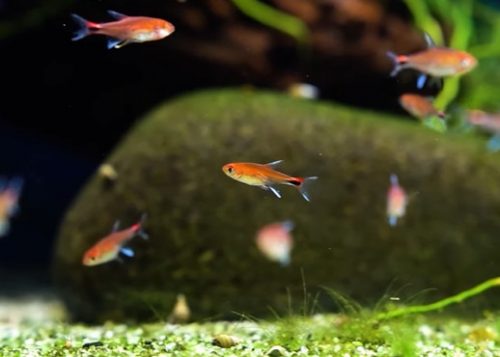
- Scientific name: Axelrodia riesei
- Size: 0.6–0.8 inches
- Tank size: Minimum 10 gallons
- Care level: Easy to moderate
- Temperament: Peaceful
- Water parameters: 68–82.4°F, pH 5.0–7.0, soft water (2–6 dGH)
- Diet: Omnivore (micro-pellets, flake foods, small live or frozen foods like daphnia)
- Lifespan: 5–10 years
Ruby tetras feature a brilliant red body with a black spot on their rear fin, making them a standout in nano tanks. Suitable for 10-gallon tanks, they require a group of 6–8 for schooling. Less hardy than ember tetras, they’re not ideal for complete beginners. A well-planted tank with hiding spots (e.g., cryptocoryne, ferns) and a dark substrate enhances their coloration. Add Indian almond leaves to maintain slightly acidic, soft water. Avoid larger or boisterous tank mates, and use a gentle filter with regular water testing to ensure pristine conditions.
Jelly Bean Tetra

- Scientific name: Ladigesia roloffi
- Size: Up to 1.25 inches
- Tank size: Minimum 10 gallons
- Care level: Easy
- Temperament: Peaceful
- Water parameters: 76–82°F, pH 6.5–7.2, soft to moderately hard water (4–10 dGH)
- Diet: Omnivore (flake foods, micro-pellets, live or frozen brine shrimp, bloodworms)
- Lifespan: 3–5 years
Jelly bean tetras, with neon-green bodies and orange fin highlights, thrive in 10-gallon species-only tanks due to their specific needs. Keep 8–10 for schooling. Their preference for highly acidic, low-light environments requires dense vegetation (e.g., Amazon swords, Java fern) and floating plants. Indian almond or oak leaves increase acidity and provide cover. A dark substrate enhances their colors. Use a sponge filter and perform 20–30% weekly water changes to maintain water quality. Avoid tank mates with differing water needs or aggressive behaviors.
Red Line Tetra
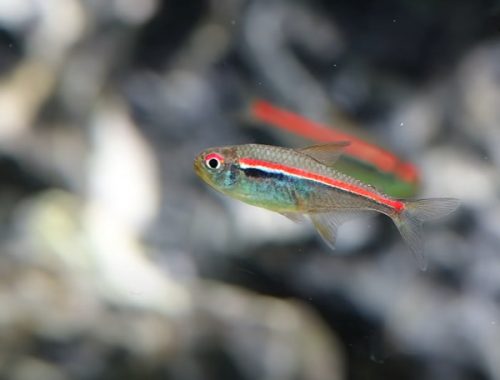
- Scientific name: Hyphessobrycon amapaensis
- Size: 1–1.2 inches
- Tank size: Minimum 10 gallons
- Care level: Very easy
- Temperament: Peaceful
- Water parameters: 73–82°F, pH 5.8–6.3, soft to moderately hard water (4–8 dGH)
- Diet: Omnivore (flake foods, micro-pellets, live or frozen brine shrimp, bloodworms)
- Lifespan: 3–5 years
Red line tetras feature a silver body with a bold red line, accented by white and black lines and yellow-tinged fins. Very easy to care for, they’re perfect for beginners. Keep 6 or more in a 10-gallon tank with plants (e.g., Java moss, Anubias) and hiding spots like driftwood. Indian almond leaves help maintain slightly acidic water. Ensure peaceful tank mates that don’t outcompete them for food. A gentle filter and 20–25% weekly water changes keep them healthy.
Flame Tetra
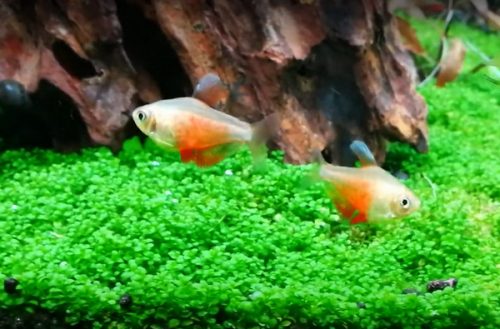
- Scientific name: Hyphessobrycon flammeus
- Size: 0.8–1 inches
- Tank size: Minimum 15 gallons
- Care level: Easy
- Temperament: Peaceful
- Water parameters: 72–82°F, pH 5.5–7.5, soft to moderately hard water (4–12 dGH)
- Diet: Omnivore (flake foods, micro-pellets, live or frozen daphnia, brine shrimp)
- Lifespan: 3–5 years
Flame tetras, or Von Rio tetras, have silvery bodies with bright red fins, making them beginner-friendly. Keep 6–8 in a 15-gallon tank with dense vegetation (e.g., cryptocoryne, Vallisneria) and open swimming areas. They tolerate a broad pH range but prefer slightly acidic water. A dark substrate enhances their colors. Use a gentle filter and 20–25% weekly water changes. They coexist well with peaceful nano fish like ember tetras or cherry shrimp.
Cardinal Tetra
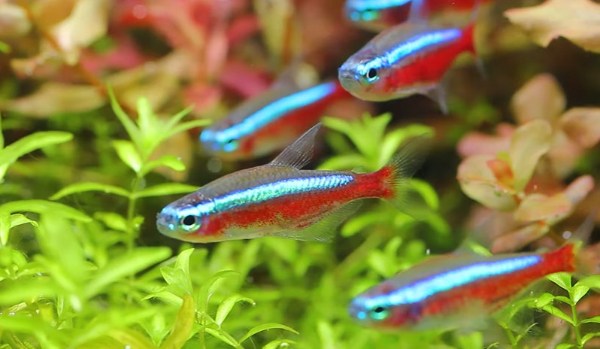
- Scientific name: Paracheirodon axelrodi
- Size: Up to 1.4 inches
- Tank size: Minimum 15 gallons
- Care level: Moderate
- Temperament: Peaceful
- Water parameters: 73–81°F, pH 3.5–7.5, very soft to soft water (1–6 dGH)
- Diet: Omnivore (flake foods, micro-pellets, live or frozen brine shrimp, bloodworms)
- Lifespan: 4–5 years
Cardinal tetras, with iridescent blue and deep red stripes, require a 15-gallon tank and a school of 6–8. Their moderate care level stems from sensitivity to water quality. Provide dense planting (e.g., Amazon swords, Java fern), a dark substrate, and open swimming areas. Maintain highly acidic, soft water with peat or Indian almond leaves. Use a gentle filter and 25–30% weekly water changes to keep nitrate levels low. Avoid aggressive or large tank mates.
Neon Tetra
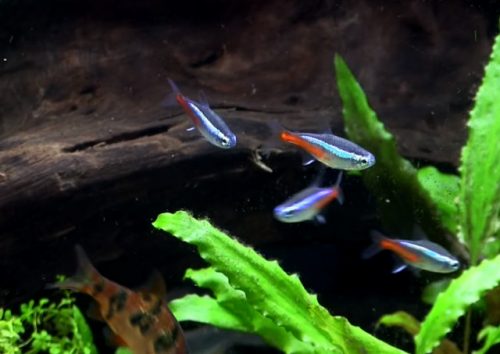
- Scientific name: Paracheirodon innesi
- Size: Up to 1.2 inches
- Tank size: Minimum 10 gallons
- Care level: Easy
- Temperament: Peaceful
- Water parameters: 70–82°F, pH 4.0–7.5, soft to moderately hard water (2–10 dGH)
- Diet: Omnivore (flake foods, micro-pellets, live or frozen brine shrimp, daphnia)
- Lifespan: 2–3 years
Neon tetras, iconic for their blue and red stripes, are hardy and suitable for 10-gallon tanks, though 15 gallons is ideal for schools of 10 or more. Add to established tanks with dense vegetation (e.g., Java moss, Anubias) and open swimming areas. They tolerate a wide pH range but prefer slightly acidic water. Regular 20–25% water changes and a gentle filter prevent nitrate buildup. Avoid sudden parameter changes and aggressive tank mates.
Green Neon Tetra

- Scientific name: Paracheirodon simulans
- Size: Up to 1 inch
- Tank size: Minimum 10 gallons
- Care level: Easy
- Temperament: Peaceful
- Water parameters: 75–85°F, pH 5.0–6.5, soft water (2–6 dGH)
- Diet: Omnivore (flake foods, micro-pellets, live or frozen brine shrimp, daphnia)
- Lifespan: 2–3 years
Green neon tetras, resembling neon tetras but with a blue-green stripe, are ideal for 10-gallon tanks. Keep 8–10 for schooling to reduce stress. Their small size requires peaceful, similarly sized tank mates like other small tetras or shrimp, as aggressive or larger fish may prey on or stress them. Provide a tank with dense plants (e.g., Java moss, cryptocoryne), a dark substrate, and low lighting to mimic their Amazonian habitat. Indian almond leaves help maintain acidic water. Use a sponge filter and 20–25% weekly water changes to ensure stability.
Glowlight Tetra

- Scientific name: Hemigrammus erythrozonus
- Size: 1.0–1.5 inches
- Tank size: Minimum 10 gallons
- Care level: Easy
- Temperament: Peaceful
- Water parameters: 72–80°F, pH 6.0–7.5, soft to moderately hard water (4–12 dGH)
- Diet: Omnivore (flake foods, micro-pellets, small live or frozen foods like brine shrimp)
- Lifespan: 3–5 years
Glowlight tetras display a striking neon-orange line across their translucent bodies, ideal for nano tanks. They thrive in groups of 6–10 for schooling behavior. A planted tank with dim lighting and a dark substrate enhances their glow. Use a gentle filter and maintain stable water conditions with regular testing. Avoid aggressive tank mates to keep them stress-free.
Black Neon Tetra

- Scientific name: Hyphessobrycon herbertaxelrodi
- Size: Up to 1.4 inches
- Tank size: Minimum 15 gallons
- Care level: Easy
- Temperament: Peaceful
- Water parameters: 68–82°F, pH 5.0–7.5, soft to moderately hard water (4–10 dGH)
- Diet: Omnivore (flake foods, micro-pellets, live or frozen brine shrimp, bloodworms)
- Lifespan: 3–5 years
Black neon tetras, with a white line above a black line resembling a braid, are hardy and suitable for 15-gallon tanks. Keep 6 or more for schooling. A darker substrate and subdued lighting enhance their appearance. Provide plants (e.g., Java fern, Anubias) and hiding spots like driftwood. They tolerate a range of water conditions but prefer slightly acidic water. Use a gentle filter and 20–25% weekly water changes. They coexist well with other peaceful nano fish.
Green Fire Tetra
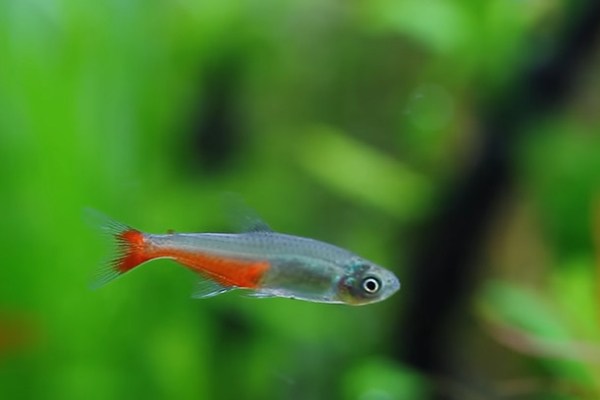
- Scientific name: Aphyocharax rathbuni
- Size: 0.8–1.2 inches
- Tank size: Minimum 10 gallons
- Care level: Easy to moderate
- Temperament: Peaceful
- Water parameters: 70–82°F, pH 6.0–7.5, soft water (2–8 dGH)
- Diet: Omnivore (micro-pellets, flakes, small live or frozen foods like daphnia)
- Lifespan: 4–6 years
Green Fire tetras showcase a vibrant greenish sheen, making them a unique addition to nano tanks. Keep them in groups of 6–8 for optimal schooling. A tank with plants like java moss and a dark substrate highlights their color. Maintain soft, slightly acidic water with Indian almond leaves and use a low-flow filter. Avoid housing with boisterous or larger fish.
Red Cherry Tetra
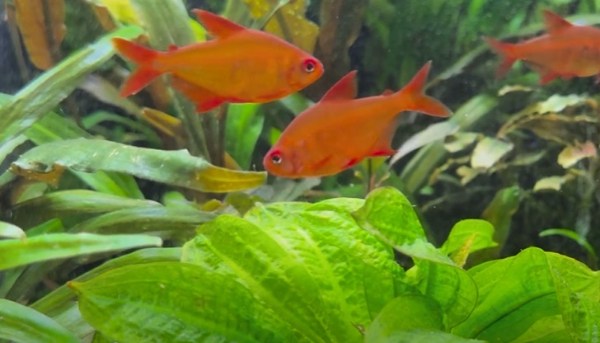
- Scientific name: Axelrodia riesei
- Size: 0.6–0.8 inches
- Tank size: Minimum 10 gallons
- Care level: Easy to moderate
- Temperament: Peaceful
- Water parameters: 68–82°F, pH 5.0–7.0, soft water (2–6 dGH)
- Diet: Omnivore (micro-pellets, flakes, small live or frozen foods like daphnia)
- Lifespan: 5–10 years
Red Cherry tetras, with their vivid red bodies, are perfect for nano tanks but differ from Ember tetras in their slender shape. House in groups of 6–8 for schooling. A planted tank with hiding spots like cryptocoryne and a dark substrate enhances their brilliance. Use a gentle filter and maintain soft, acidic water with regular testing. Avoid larger or aggressive tank mates.
African Moon Tetra
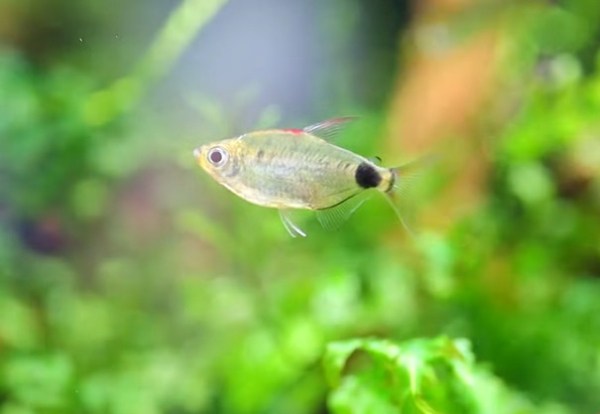
- Scientific name: Bathyaethiops caudomaculatus
- Size: 1.5–2.0 inches
- Tank size: Minimum 10 gallons
- Care level: Easy to moderate
- Temperament: Peaceful
- Water parameters: 72–80°F, pH 6.0–7.5, soft water (4–8 dGH)
- Diet: Omnivore (high-quality flakes, micro-pellets, live or frozen foods like bloodworms or daphnia)
- Lifespan: 3–5 years
African Moon tetras, with their silvery-blue bodies and distinctive black and red spot near the tail, are a striking addition to nano tanks. They thrive in groups of 6–10 for schooling and prefer a well-planted tank with java moss or water sprite to mimic their Congo River Basin habitat. A dark substrate and gentle filtration enhance their comfort. Avoid aggressive or larger tank mates to prevent stress. Regular water changes (25% weekly) and testing for ammonia and nitrite (0 ppm) are crucial.
Glofish
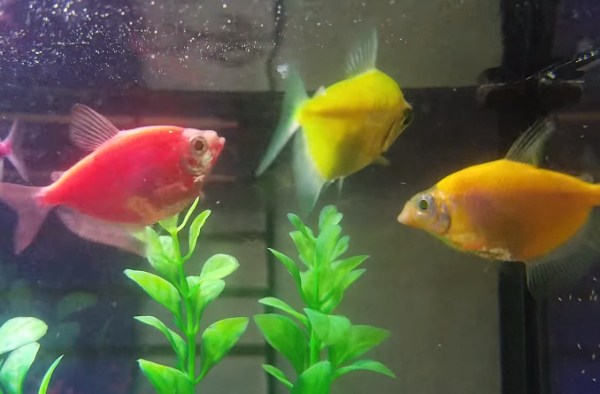
- Scientific name: Gymnocorymbus sp. (genetically modified black skirt tetra)
- Size: 2.0–3.0 inches
- Tank size: Minimum 10 gallons
- Care level: Easy
- Temperament: Peaceful
- Water parameters: 72–82°F, pH 6.0–8.0, soft to moderately hard water (4–15 dGH)
- Diet: Omnivore (flakes, pellets, live or frozen foods like brine shrimp)
- Lifespan: 3–5 years
Glofish tetras, known for their vibrant fluorescent colors (Starfire Red, Moonrise Pink, Sunburst Orange, Electric Green, Cosmic Blue, Galactic Purple), glow under blue or black lighting. These schooling fish need groups of 6 or more to reduce stress. A 10-gallon tank with plants, rocks, and open swimming space suits them well. Use a moderate-flow filter and maintain stable water parameters with regular testing. They coexist with peaceful fish like guppies, mollies, or neon tetras but avoid aggressive species like tiger barbs.
Flag Tetra
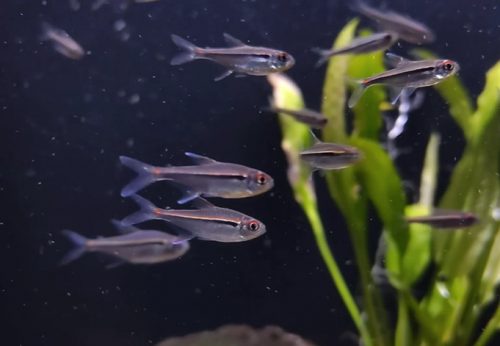
- Scientific name: Hyphessobrycon heterorhabdus
- Size: Up to 1.4 inches
- Tank size: Minimum 15 gallons
- Care level: Easy
- Temperament: Very peaceful
- Water parameters: 68–79°F, pH 5.5–7.5, soft to moderately hard water (4–10 dGH)
- Diet: Omnivore (flake foods, micro-pellets, live or frozen daphnia, brine shrimp)
- Lifespan: 3–5 years
Flag tetras, also called Belgian flag tetras, feature red, black, and gold stripes. Very peaceful, they suit 15-gallon tanks with 8–10 for schooling. Their compatibility with most fish makes them ideal for community setups. Provide dense vegetation (e.g., Vallisneria, Java moss) and open swimming areas. They tolerate a range of water conditions but prefer slightly acidic water. A gentle filter and 20–25% weekly water changes maintain health.
Black Phantom Tetra
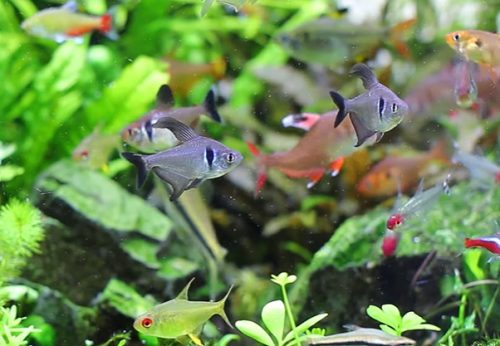
- Scientific name: Hyphessobrycon megalopterus
- Size: Up to 1.4 inches
- Tank size: Minimum 15 gallons
- Care level: Moderate
- Temperament: Peaceful
- Water parameters: 68–82°F, pH 5.0–7.0, soft to moderately hard water (4–8 dGH)
- Diet: Omnivore (flake foods, micro-pellets, live or frozen brine shrimp, bloodworms)
- Lifespan: 5 years
Black phantom tetras have a blocky, light grey body with long, flowy fins, which males extend during mating or territorial displays. Suitable for 15-gallon tanks, keep 6–8 for schooling. Their moderate care level stems from occasional fin damage in males, which regrows. Provide plants (e.g., Java fern, cryptocoryne) and hiding spots. They prefer slightly acidic water. Use a gentle filter and 20–25% weekly water changes. Avoid aggressive tank mates.
Red Phantom Tetra
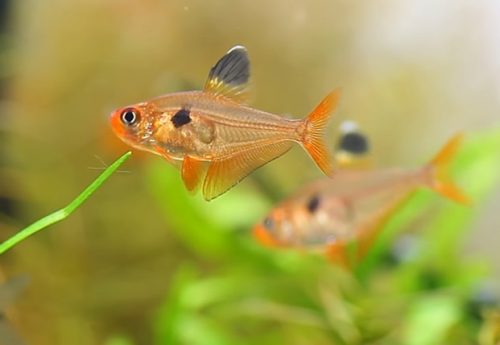
- Scientific name: Hyphessobrycon sweglesi
- Size: Up to 1.4 inches
- Tank size: Minimum 15 gallons
- Care level: Moderate
- Temperament: Peaceful
- Water parameters: 68–82°F, pH 5.0–7.0, soft to moderately hard water (4–8 dGH)
- Diet: Omnivore (flake foods, micro-pellets, live or frozen brine shrimp, bloodworms)
- Lifespan: 5 years
Red phantom tetras, with a distinct red hue, pair well with black phantom tetras in 15-gallon tanks for a striking contrast. Keep 6–8 for schooling. Their moderate care level reflects sensitivity to water quality. Provide dense plants (e.g., Anubias, Java moss) and hiding spots. Maintain slightly acidic water with Indian almond leaves. Use a gentle filter and 20–25% weekly water changes. Avoid aggressive or large tank mates.
Tetras for Mid-Sized Aquariums (20–25 Gallons)
These tetras are larger or have specific needs that require more space, making them suitable for 20–25-gallon tanks. They may present slightly more challenge than nano tank tetras but are still accessible for beginners with proper care.
Rosy Tetra
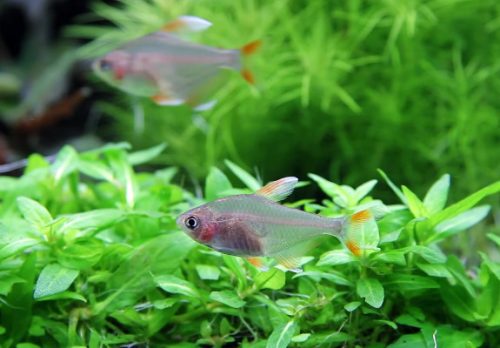
- Scientific name: Hyphessobrycon rosaceus
- Size: Up to 1.6 inches
- Tank size: Minimum 20 gallons
- Care level: Easy
- Temperament: Peaceful
- Water parameters: 75–82°F, pH 5.5–7.5, soft to moderately hard water (4–12 dGH)
- Diet: Omnivore (flake foods, micro-pellets, live or frozen brine shrimp, bloodworms)
- Lifespan: 3–5 years
Rosy tetras, with pale pink bodies and darker red spots, feature fan-like fins in males used in mating displays. Hardy and beginner-friendly, they suit 20-gallon community tanks with 6–10 for schooling. Their colors are brighter in acidic water. Provide dense plants (e.g., Amazon swords, Vallisneria) and open swimming areas. They coexist well with peaceful fish like corydoras or other tetras. Use a gentle filter and 20–25% weekly water changes.
Blue Tetra

- Scientific name: Knodus borki
- Size: Up to 2 inches
- Tank size: Minimum 20 gallons
- Care level: Easy
- Temperament: Slightly aggressive
- Water parameters: 72–78°F, pH 5.5–7.0, soft to moderately hard water (4–10 dGH)
- Diet: Omnivore (flake foods, micro-pellets, live or frozen daphnia, bloodworms)
- Lifespan: 2–4 years
Blue tetras, reaching 2 inches, are lively and slightly aggressive, requiring a 20-gallon tank with 6–8 for schooling. Provide ample space and cover (e.g., Java fern, driftwood) to reduce tension. They coexist with other tetras but avoid slow-moving or long-finned fish. Maintain slightly acidic water with a gentle filter and 20–25% weekly water changes to keep them healthy.
Silvertip Tetra
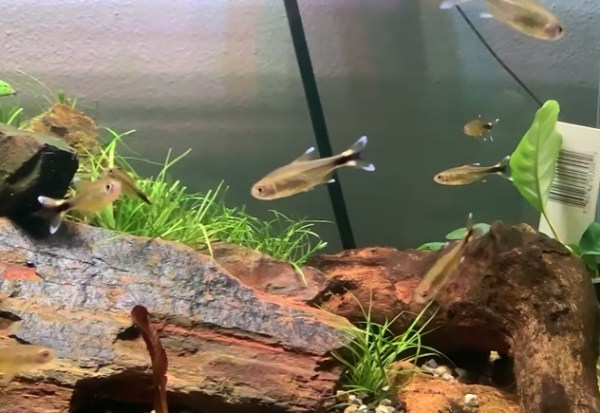
- Scientific name: Hasemania nana
- Size: 1.0–1.5 inches
- Tank size: Minimum 20 gallons
- Care level: Easy
- Temperament: Peaceful, active
- Water parameters: 70–82°F, pH 6.0–7.5, soft to moderately hard water (4–10 dGH)
- Diet: Omnivore (flakes, micro-pellets, small live or frozen foods like brine shrimp)
- Lifespan: 5–7 years
Silvertip tetras are known for their bright yellow bodies and striking silver-white fin tips. They thrive in groups of 8–12, adding lively movement to medium tanks. A planted tank with open swimming space and a dark substrate suits them well. Use a gentle to moderate filter and maintain stable water conditions. Avoid fin-nipping or aggressive tank mates.
Rainbow Tetra
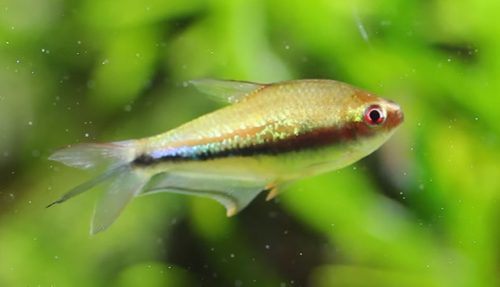
- Scientific name: Nematobrycon lacortei
- Size: 1.2–1.5 inches
- Tank size: Minimum 25 gallons
- Care level: Easy
- Temperament: Semi-aggressive
- Water parameters: 72–80°F, pH 5.0–8.0, soft to moderately hard water (4–12 dGH)
- Diet: Omnivore (flake foods, micro-pellets, live or frozen brine shrimp, bloodworms)
- Lifespan: 3–5 years
Rainbow tetras, with iridescent males and muted females, require a 25-gallon tank due to their semi-aggressive nature, especially among males. Keep 6–10 for schooling. Provide dense plants (e.g., cryptocoryne, Java moss) and hiding spots to reduce aggression. They’re not beginner-friendly but rewarding with proper setup. Use a gentle filter and 20–25% weekly water changes.
X-ray Tetra (Pristella Tetra)
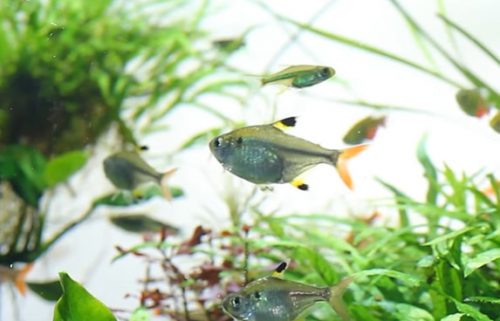
- Scientific name: Pristella maxillaris
- Size: Up to 1.8 inches
- Tank size: Minimum 20 gallons
- Care level: Easy
- Temperament: Peaceful
- Water parameters: 72–82°F, pH 6.0–7.5, soft to moderately hard water (4–12 dGH)
- Diet: Omnivore (flake foods, micro-pellets, live or frozen daphnia, brine shrimp)
- Lifespan: 3–5 years
X-ray Tetra, growing to 1.8 inches, are peaceful and ideal for 20-gallon community tanks with 6 or more for schooling. Provide dense plants (e.g., Vallisneria, Java fern) and open swimming areas. They tolerate a range of water conditions but prefer slightly acidic water. Use a gentle filter and 20–25% weekly water changes. They coexist well with other tetras and dwarf cichlids.
Candy Cane Tetra
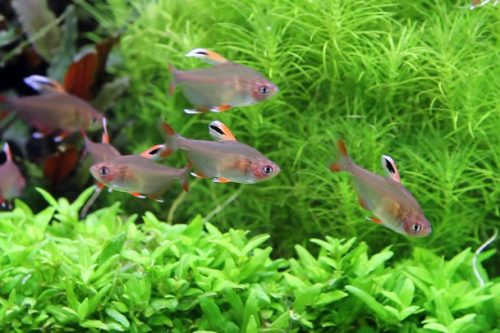
- Scientific name: Hyphessobrycon bentosi
- Size: 1.6–1.8 inches
- Tank size: Minimum 20 gallons
- Care level: Easy
- Temperament: Peaceful
- Water parameters: 73–82°F, pH 6.0–7.2, soft to moderately hard water (4–10 dGH)
- Diet: Omnivore (flake foods, micro-pellets, live or frozen brine shrimp, bloodworms)
- Lifespan: 3–5 years
Candy cane tetras, with pink bodies often confused with rosy tetras, suit 20-gallon tanks with 6 or more for schooling. Provide a dark, densely planted tank (e.g., Java moss, driftwood, river rocks) to enhance their colors. They’re peaceful and compatible with similar-sized fish. Use a gentle filter and 20–25% weekly water changes to maintain water quality.
Bloodfin Tetra

- Scientific name: Aphyocharax anisitsi
- Size: Up to 2.2 inches
- Tank size: Minimum 20 gallons
- Care level: Easy
- Temperament: Peaceful, may nip fins of angelfish or guppies
- Water parameters: 64–82°F, pH 6.0–8.0, soft to moderately hard water (4–12 dGH)
- Diet: Omnivore (flake foods, micro-pellets, live or frozen daphnia, bloodworms)
- Lifespan: 3–5 years
Bloodfin tetras, with bright bodies and red fin tips, are hardy but may nip fins of long-finned fish like angelfish or guppies. Keep 6–10 in a 20-gallon tank with dense plants (e.g., Amazon swords, Java fern) and open areas. They tolerate a wide range of water conditions. Use a gentle filter and 20–25% weekly water changes.
Emperor Tetra
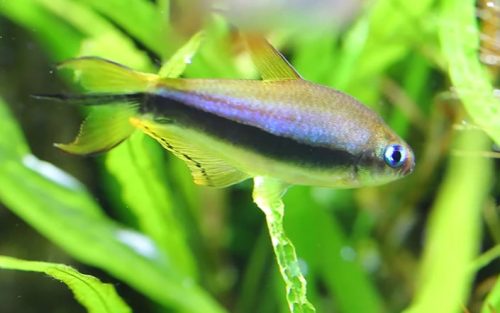
- Scientific name: Nematobrycon palmeri
- Size: Up to 1.6 inches
- Tank size: Minimum 20 gallons
- Care level: Easy
- Temperament: Peaceful
- Water parameters: 73–81°F, pH 5.0–7.5, soft to moderately hard water (4–10 dGH)
- Diet: Omnivore (flake foods, micro-pellets, live or frozen brine shrimp, bloodworms)
- Lifespan: 3–5 years
Emperor tetras, with bold black stripes and yellow-purple hues in males, suit 20-gallon community tanks with 6 or more for schooling. Provide dense plants (e.g., Java moss, cryptocoryne) to mimic their Colombian river habitat. They coexist with corydoras, discus, and other tetras. Use a gentle filter and 20–25% weekly water changes.
Rummy Nose Tetra
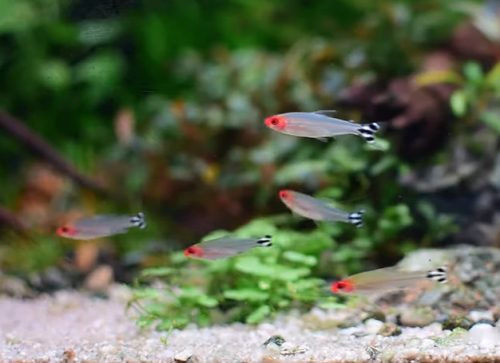
- Scientific name: Hemigrammus rhodostomus
- Size: Up to 2 inches
- Tank size: Minimum 20 gallons
- Care level: Easy
- Temperament: Peaceful
- Water parameters: 76–80°F, pH 5.5–7.0, soft to moderately hard water (4–8 dGH)
- Diet: Omnivore (flake foods, micro-pellets, live or frozen daphnia, brine shrimp)
- Lifespan: 3–5 years
Rummy nose tetras, with stunning coloration, thrive in 20-gallon blackwater setups with tannins from Indian almond leaves or peat. Keep 6–10 for schooling. Provide dense plants (e.g., Java fern, Amazon swords) and a dark substrate. They tolerate slightly less acidic water but prefer acidic conditions. Use a gentle filter and 20–25% weekly water changes.
Diamond Tetra

- Scientific name: Moenkhausia pittieri
- Size: Males up to 2.4 inches, females smaller
- Tank size: Minimum 20 gallons
- Care level: Easy
- Temperament: Peaceful
- Water parameters: 72–82°F, pH 5.5–7.0, soft to moderately hard water (4–10 dGH)
- Diet: Omnivore (flake foods, micro-pellets, live or frozen brine shrimp, bloodworms)
- Lifespan: 3–5 years
Diamond tetras, with males reaching 2.4 inches, are easy to breed and suit 20-gallon community tanks with 6 or more for schooling. Provide dense plants (e.g., Vallisneria, Java moss) for hiding, especially for fry. They’re peaceful and compatible with similar-sized fish. Use a gentle filter and 20–25% weekly water changes.
Black Skirt Tetra
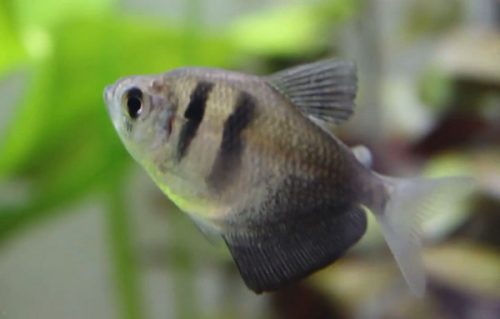
- Scientific name: Gymnocorymbus ternetzi
- Size: Up to 2.4 inches
- Tank size: Minimum 20 gallons
- Care level: Easy
- Temperament: Peaceful
- Water parameters: 68–78°F, pH 6.0–7.0, soft to moderately hard water (4–12 dGH)
- Diet: Omnivore (flake foods, micro-pellets, live or frozen daphnia, bloodworms)
- Lifespan: 3–5 years
Black skirt tetras, with black patterns and various fin lengths, are hardy and easy to breed in 20-gallon tanks. Keep 6 or more for schooling. Provide dense plants (e.g., Java fern, cryptocoryne) for hiding. They’re peaceful and suit community setups. Use a gentle filter and 20–25% weekly water changes.
Head and Tail Light Tetra
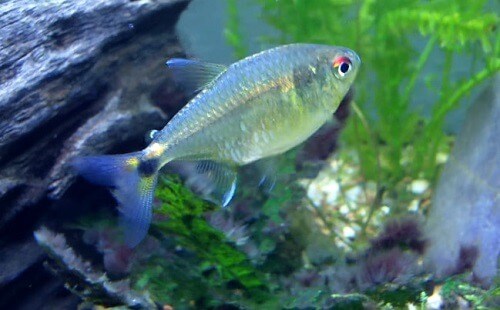
- Scientific name: Hemigrammus ocellifer
- Size: Up to 1.8 inches
- Tank size: Minimum 20 gallons
- Care level: Easy
- Temperament: Very peaceful
- Water parameters: 75–82°F, pH 5.5–7.5, soft to moderately hard water (4–12 dGH)
- Diet: Omnivore (flake foods, micro-pellets, live or frozen brine shrimp, daphnia)
- Lifespan: 3–5 years
Head and tail light tetras, named for their reflective spots, are hardy and spawn easily in 20-gallon tanks. Keep 6 or more for schooling. Provide dense plants (e.g., Amazon swords, Java moss) and open areas. They tolerate a range of pH but prefer acidic water. Use a gentle filter and 20–25% weekly water changes.
Serpae Tetra
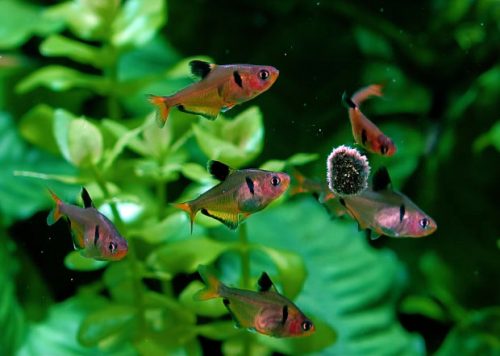
- Scientific name: Hyphessobrycon eques
- Size: Up to 1.6 inches
- Tank size: Minimum 20 gallons
- Care level: Easy
- Temperament: Fin nipping
- Water parameters: 68–82°F, pH 5.5–7.0, soft to moderately hard water (4–10 dGH)
- Diet: Omnivore (flake foods, micro-pellets, live or frozen brine shrimp, bloodworms)
- Lifespan: 3–5 years
Serpae tetras, with bright red bodies and black markings, are active and may nip fins of long-finned or slow-moving fish. Keep 8 or more in a 20-gallon tank with dense plants (e.g., bogwood, Java fern) and subdued lighting to enhance colors. Maintain soft, acidic water with a gentle filter and 20–25% weekly water changes.
Penguin Tetra
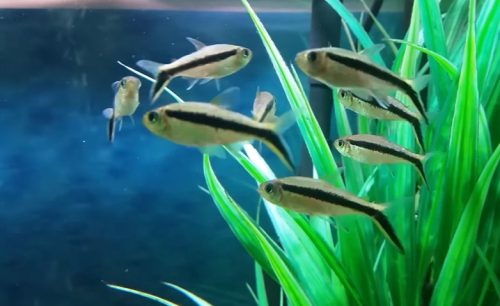
- Scientific name: Thayeria boehlkei
- Size: Up to 1.4 inches
- Tank size: Minimum 20 gallons
- Care level: Easy
- Temperament: Peaceful
- Water parameters: 73–82°F, pH 5.5–8.0, soft to moderately hard water (4–12 dGH)
- Diet: Omnivore (flake foods, micro-pellets, live or frozen brine shrimp, bloodworms)
- Lifespan: 3–5 years
Penguin tetras, with a silver belly and black stripe, suit 20-gallon community tanks with 6 or more for schooling. Provide dense plants (e.g., Java fern, cryptocoryne) and open areas. They tolerate a wide pH range but prefer slightly acidic water. Use a gentle filter and 20–25% weekly water changes.
Lemon Tetra
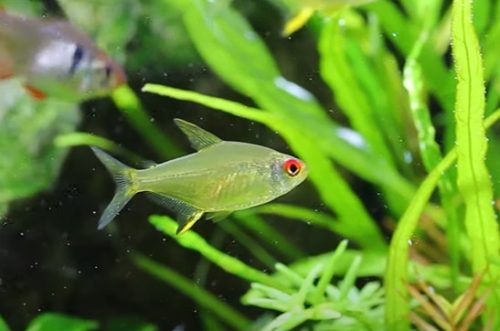
- Scientific name: Hyphessobrycon pulchripinnis
- Size: Up to 1.6 inches
- Tank size: Minimum 20 gallons
- Care level: Easy
- Temperament: Peaceful
- Water parameters: 68–82°F, pH 5.0–7.5, soft to moderately hard water (4–10 dGH)
- Diet: Omnivore (flake foods, micro-pellets, live or frozen daphnia, bloodworms)
- Lifespan: 3–5 years
Lemon tetras, with light yellow, near-transparent bodies and red eyes, suit 20-gallon tanks with 8 or more for schooling. Their vibrant red eyes indicate health. Provide dense plants (e.g., Amazon swords, Java moss) for cover. They prefer acidic water. Use a gentle filter and 20–25% weekly water changes.
Blue Emperor Tetra
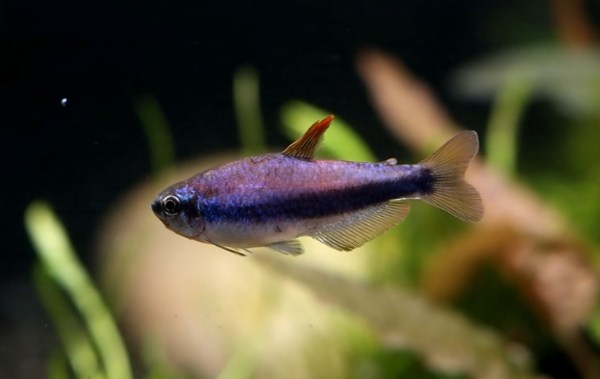
- Scientific name: Inpaichthys kerri
- Size: 1.2–1.5 inches
- Tank size: Minimum 20–29 gallons
- Care level: Easy to moderate
- Temperament: Peaceful
- Water parameters: 72–81°F, pH 6.0–7.5, soft to moderately hard water (4–10 dGH)
- Diet: Omnivore (flakes, micro-pellets, small live or frozen foods like brine shrimp)
- Lifespan: 3–5 years
Blue Emperor tetras, with their vibrant blue bodies and yellow fins, are versatile for medium to large tanks. Keep in groups of 6–10 for schooling. A tank with plants, driftwood, and open space enhances their beauty. Use a gentle to moderate filter and maintain stable water parameters. They coexist well with other peaceful fish, avoiding aggressive or much larger tank mates.
Tetras for Large Aquariums (29+ Gallons)
These tetras are larger, have significant schooling needs, or exhibit behaviors that require spacious tanks, making them suitable for 29-gallon or larger setups.
Blind Cave Tetra
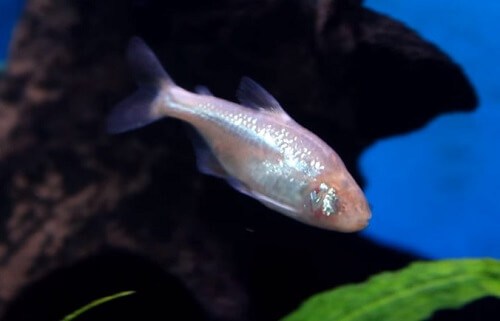
- Scientific name: Astyanax mexicanus
- Size: Up to 3.5 inches
- Tank size: Minimum 29 gallons
- Care level: Easy
- Temperament: Peaceful
- Water parameters: 68–77°F, pH 6.5–8.0, soft to moderately hard water (4–12 dGH)
- Diet: Omnivore (flake foods, sinking pellets, live or frozen brine shrimp, bloodworms)
- Lifespan: 5–7 years
Blind cave tetras, unique for their blindness, suit 29-gallon tanks with 6 or more for schooling. They don’t require elaborate setups but benefit from nooks and crannies (e.g., rocks, driftwood) for hiding. Keep with non-aggressive fish. They tolerate a wide pH range. Use a gentle filter and 20–25% weekly water changes.
Colombian Tetra
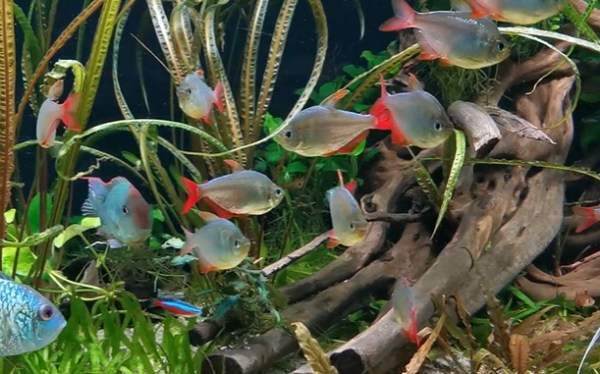
- Scientific name: Hyphessobrycon columbianus
- Size: 2.0–2.5 inches
- Tank size: Minimum 29 gallons
- Care level: Moderate
- Temperament: Semi-aggressive
- Water parameters: 72–80°F, pH 6.0–7.5, soft to moderately hard water (4–12 dGH)
- Diet: Omnivore (pellets, flakes, live or frozen foods like bloodworms)
- Lifespan: 5–7 years
Colombian tetras have a robust build with a silvery-blue body, but their semi-aggressive nature requires a larger tank. Keep in groups of 8–12 to diffuse aggression. A spacious tank with plants, driftwood, and open swimming areas suits them. Use a strong filter due to their active nature and test water frequently. Pair with similarly sized, non-passive fish to avoid bullying.
Bleeding Heart Tetra
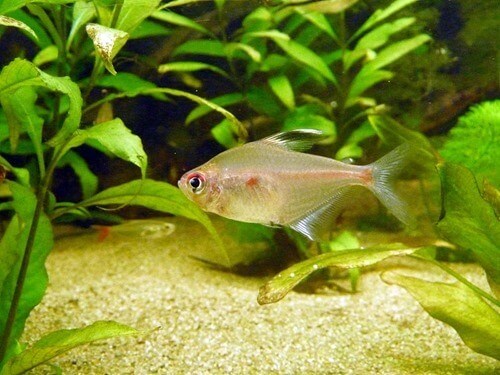
- Scientific name: Hyphessobrycon erythrostigma
- Size: Up to 2.4 inches
- Tank size: Minimum 30 gallons
- Care level: Easy
- Temperament: Peaceful
- Water parameters: 70–82°F, pH 4.0–7.5, soft to moderately hard water (4–10 dGH)
- Diet: Omnivore (flake foods, micro-pellets, live or frozen daphnia, bloodworms)
- Lifespan: 3–5 years
Bleeding heart tetras, with silver-white bodies and pink patterns with a red “heart” dot, suit 30-gallon tanks with 6–8 for schooling. Plants are not essential but provide hiding spots (e.g., driftwood). They prefer acidic water. Use a gentle filter and 20–25% weekly water changes.
Buenos Aires Tetra
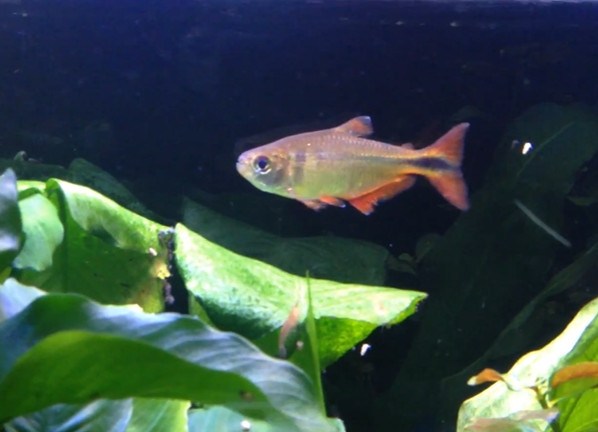
- Scientific name: Hyphessobrycon anisitsi
- Size: Up to 2.4 inches
- Tank size: Minimum 30 gallons
- Care level: Easy
- Temperament: May nip fins
- Water parameters: 64–82°F, pH 5.5–8.5, soft to moderately hard water (4–12 dGH)
- Diet: Omnivore (flake foods, micro-pellets, live or frozen brine shrimp, bloodworms)
- Lifespan: 3–5 years
Buenos Aires tetras are adaptable but may nip fins as they grow. Keep 6–8 in a 30-gallon tank with dense plants (e.g., Java fern, Vallisneria) to reduce aggression. Avoid long-finned fish. They tolerate a wide range of conditions. Use a gentle filter and 20–25% weekly water changes.
Red-eye Tetra
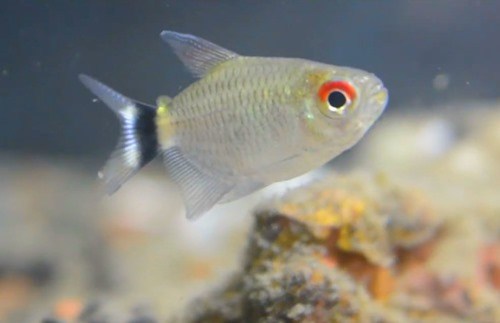
- Scientific name: Moenkhausia sanctaefilomenae
- Size: Up to 2.8 inches
- Tank size: Minimum 30 gallons
- Care level: Easy
- Temperament: May nip fins of long-finned fish
- Water parameters: 72–79°F, pH 6.0–8.0, soft to moderately hard water (4–12 dGH)
- Diet: Omnivore (flake foods, micro-pellets, live or frozen daphnia, bloodworms)
- Lifespan: 3–5 years
Red-eye tetras, with silvery bodies and red eyes, suit 30-gallon tanks with 6 or more for schooling. They may nip long-finned fish and chew plants, so use hardy plants (e.g., Anubias, Java fern). They tolerate a wide pH range. Use a gentle filter and 20–25% weekly water changes.
Congo Tetra
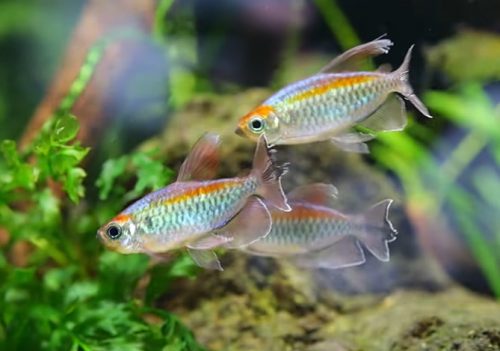
- Scientific name: Phenacogrammus interruptus
- Size: Males up to 3.2 inches, females 2.4 inches
- Tank size: Minimum 55 gallons
- Care level: Easy
- Temperament: Peaceful
- Water parameters: 73–82°F, pH 6.0–7.5, soft to moderately hard water (4–10 dGH)
- Diet: Omnivore (flake foods, micro-pellets, live or frozen brine shrimp, bloodworms)
- Lifespan: 3–5 years
Congo tetras, with iridescent bodies and red heads, suit 55-gallon tanks with 6 or more for schooling. Keep with peaceful fish, as they’re vulnerable to aggression. Provide dense plants (e.g., Vallisneria, Amazon swords) and acidic water. Use a gentle filter and 20–25% weekly water changes.
Bucktooth Tetra
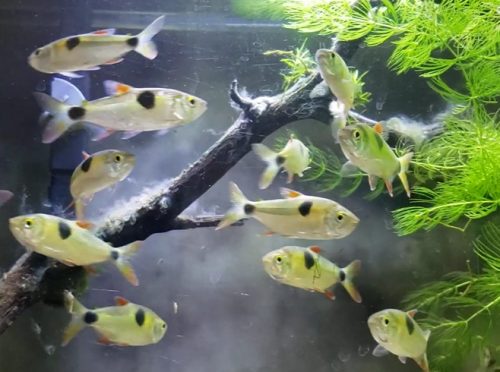
- Scientific name: Exodon paradoxus
- Size: Up to 4 inches
- Tank size: Minimum 40 gallons
- Care level: Advanced
- Temperament: Very aggressive, species-only setup
- Water parameters: 73–82°F, pH 5.5–7.5, soft to moderately hard water (4–10 dGH)
- Diet: Omnivore (flake foods, pellets, live or frozen bloodworms, brine shrimp)
- Lifespan: 5–7 years
Bucktooth tetras, highly aggressive, require a 40-gallon species-only tank with 6 or more. They may eat scales off tank mates, including their own species, if underfed. Provide dense cover (e.g., Java fern, driftwood) and monitor behavior. Use a gentle filter and 20–25% weekly water changes. Suitable only for advanced aquarists.
General Tips for Tetra Tanks
- Tank Setup: Use a heater for stable temperatures and a lid to prevent jumping. Provide dense plants, driftwood, and dark substrates to mimic natural habitats.
- Filtration: Use sponge or low-flow hang-on-back filters to avoid strong currents. Ensure proper cycling before adding fish.
- Water Quality: Perform 20–30% weekly water changes and monitor pH, temperature, and hardness with a liquid test kit. Tetras prefer soft, acidic water.
- Tank Mates: Choose peaceful, similarly sized fish (e.g., shrimp, corydoras, other tetras). Avoid aggressive or long-finned fish for nip-prone species.
- Feeding: Offer high-quality flake foods, micro-pellets, and occasional live or frozen foods. Feed small amounts 1–2 times daily to avoid overfeeding.
- Maintenance: Clean substrate lightly and avoid overstocking to manage bioload. Larger tanks offer more stability for sensitive species.
Final Thoughts
Tetras offer a range of options for aquarists, from beginner-friendly nano tank species like ember and neon tetras to challenging larger species like bucktooth tetras. By matching tank size, water parameters, and tank mates to their needs, you can create a thriving, vibrant aquarium. Always research specific requirements and monitor water quality to ensure a healthy environment for these beautiful fish.

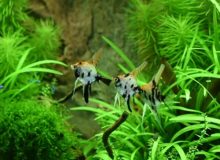
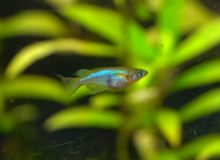
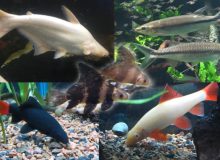


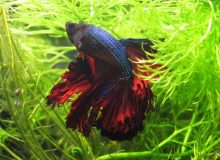
Leave a Reply